Forbes published its annual “30 under 30” list, mere days after the 2017 National Book Awards hosted its annual “5 Under 35” celebration. So it’s safe to say that this week has generated a perfect storm of ANXIETY from prospective writers and artists who feel like they’re already aging out of relevance.
You’re not, though—none of us are. Here’s the proof:
Sure, George R. R. Martin sold his first short story at the age of 21…but: His first novel still didn’t come out until 8 years after that. And A Game of Thrones, his seminal work, didn’t appear until he was in his late 40s. Robert Jordan’s first novel came out in his early 30s, but The Wheel of Time didn’t emerge until a decade after that (An interesting sidenote that we tend to forget and re-remember a lot: Martin and Jordan were born within one month of each other!) Ursula K. Le Guin started in her mid-30s. Still feeling skeptical? J. R. R. Tolkien published The Hobbit in his early 40s. The Lord of the Rings published when he was in his 60s.
It’s no different today. Patrick Rothfuss? First novel at 33. Brandon Sanderson? Finished the The Wheel of Time and The Way of Kings well into his 30s. Neil Gaiman? Finished Sandman in his mid-30s. Jacqueline Carey? Kushiel’s Dart came out when she was 36. N.K. Jemisin was 38 when The Hundred Thousand Kingdoms was published.
Okay, but those are epic fantasies (or just epics in Gaiman’s case) and they take a while to assemble. What about sci-fi?
John Scalzi’s first novel came out when he was 36. Ann Leckie’s first novel was published when she was 47. Cory Doctorow’s first novel hit when he was 32. Ender’s Game published when Orson Scott Card was 33. You can go back further to find Asimov’s first novel arriving as he crests the age of 30. His fellow Futurian Frederik Pohl started publishing novels in his late 30s.
Writers and artists: You have time. Hell, we can even leave the sci-fi/fantasy book industry altogether to find more proof of this. Lin-Manuel Miranda won his first Tony Award in his late 20s, but to get Hamilton we had to wait until Miranda was in his mid-30s.
The idea that you have to publish a seminal work in your 20s has always been bull. Which is why it was so heartening to see Tor.com Publishing author Cassandra Khaw push back at the trend on Twitter recently:
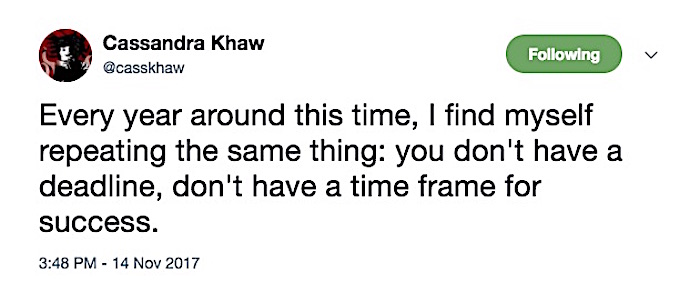
She went on to discuss the problem of the wunderkind, and the narrowness of lists like Forbes’, which necessarily have to focus on young people who have had enough opportunity (and often, lets face it, money) to achieve success early in life.
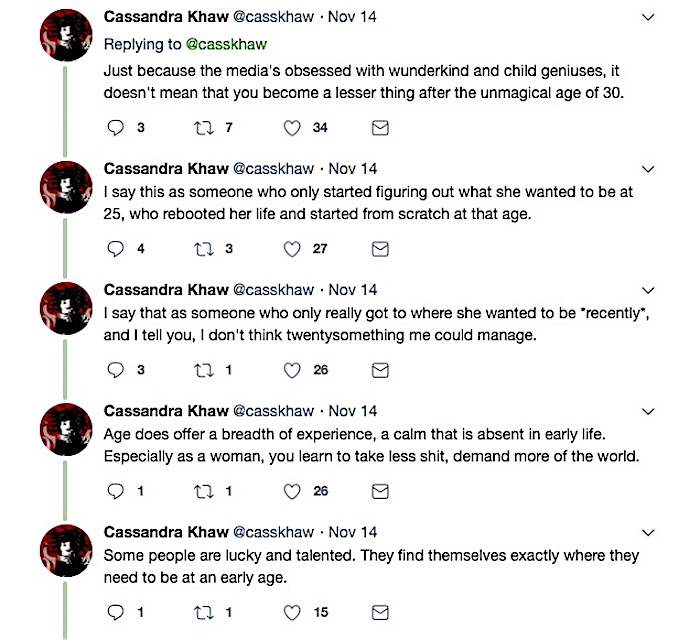
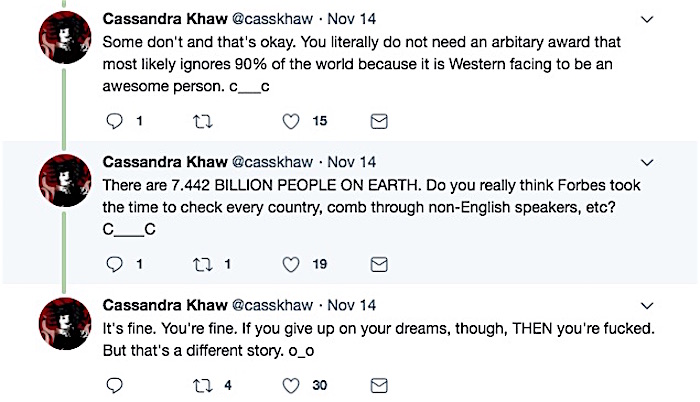
Bob Proehl, author of A Hundred Thousand Worlds, replied:
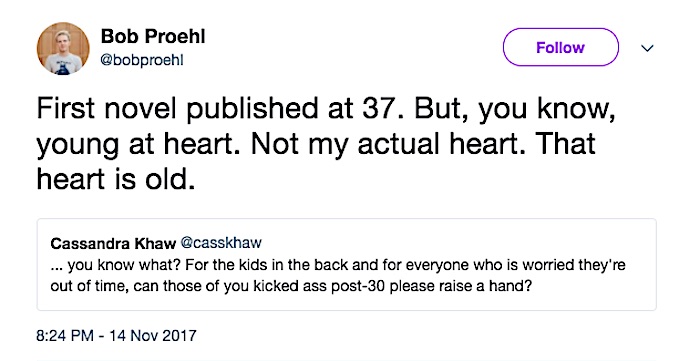
And Sunny Moraine, author of the haunting short story “eyes I dare not meet in dreams,” chimed in:
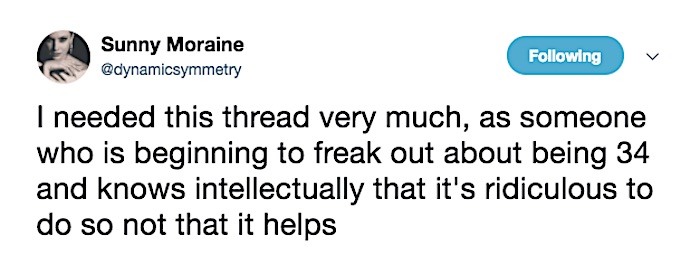
They’re not the only ones! You can read the whole thread here.
Clearly different writers find success at different times, no matter how you cherry-pick the data. However, there is ONE important thing that every successful writer does, regardless of their age. Writers…are you ready? This is the actual secret behind getting published:
They all kept writing.
It is NaNoWriMo EVERY Mo. Martin wrote stories and scripts and still does so in-between his huge novels. Asimov and Pohl wrote short fiction relentlessly, building up to novel lengths. Tolkien built his legendarium and worked on translations and taught. Jordan’s works were in the double digits before The Wheel of Time even began. And Sanderson, as we know, is a tsunami of story. Even folks who you’re just hearing about now: like Cassandra Khaw or Sunny Moraine or Nnedi Okorafor or Seanan McGuire or or or…they all share the same important quality: They keep writing.
So, prospective writers, artists, and creators: Don’t worry about time. Just keep going. If you do that, odds are that Tor.com will be writing about you someday.










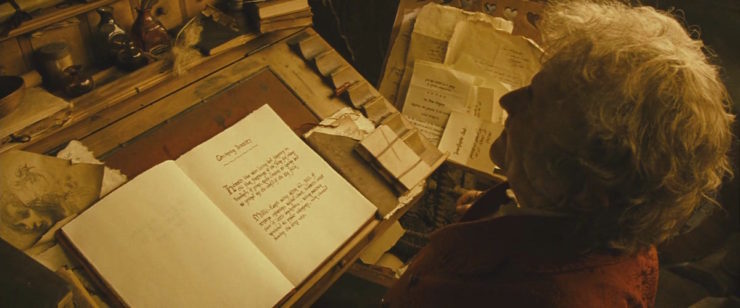
I read a Dan Simmons article (blog?) once that said there are prodigy musicians, athletes, etc. but there are no prodigy writers. You can’t write until you have some years behind you. (Which ought to mean I can write amazingly well at this point, however …)
Thank you so much for posting this–and on my thirtieth birthday!!
I only want to be published after I’m dead, that way I don’t have to worry what anybody says.
There’s even more than that:
William Gibson was 36 when Neuromancer was published, the same age as Frank Herbert when he wrote The Dragon in the Sea and Connie Willis when Water Witch was released. Alfred Bester was about 40 when The Demolished Man came out, while Anne McCaffrey was 41 at the time of Restoree and “Weyr Search”. Susanna Clarke was 44 when Jonathan Strange & Mr. Norrell was released. Jack McDevitt’s The Hercules Text was published when he was 51, slightly younger than Alice Sheldon (James Tiptree) who sold her first story when she was 52.
I turned 30 last week, so I really don’t want to read those lists. Thanks for the warneing.
I don’t aspire to be a fiction author. I have chronic hand pain, and Seanan McGuire has already written better versions of everything I would want to write. But I still want to be a nature writer. Among other things.
I am sixty-two. My advice to you young whippersnappers is to stop whining and start putting words in a row. Keep doing it long enough, and something will happen.
How old was Shakespeare when he wrote his first important piece?
It’s easy to obsess about the youngest person who wrote an important piece. It’s easier still to forget about the oldest person who wrote an important piece.
In the end, the important piece never asks how old you are when you write an important piece.
Write something important. If it’s important to you, it will find resonance somewhere – it will be important to someone else as well. It doesn’t matter how old you are.
There are wunderkinds and there are late bloomers. The important idea/thought/emotion you have to write never asks if you are a wunderkind or a late bloomer. No-one asks if the author is 30 or 70. He’ll be surprised if the author is 70 but he won’t be disappointed.
There’s room enough for important works to be written in the age of 70.
Which means people who’re 34 – don’t worry. Your wave has not passed yet. You have time – till the rest of your life. The point is to make the time count.
One of my favorite SF authors of all time is Stanley Weinbaum. Didn’t publish his first story until his mid-30s, and dead of cancer a year and a half later. But in that short time, the stuff he wrote was magical. It’s not the years in your life that count, it’s the life in your years.
This makes me feel better. I needed this. I’ll be 32 in a few months, and in the process of editing my first complete novel (not the first I’ve written, but the first I plan on trying to publish because it’s not complete garbage).
@1 Well, there’s Christopher Paolini.
Don’t forget Gene Wolfe. He was 39 when his first novel came out, and 49 when Shadow of the Torturer was released.
Lois McMaster Bujold was 37 when her first novel was published.
In less than two months, I’ll be 40. I needed this article, even if the ages in it are all still younger than I am.
I’m disappointed in your lack of attribution for your cover image :( It’s originally from Allie Brosh’s blog, Hyperbole and a Half, specifically this post: http://hyperboleandahalf.blogspot.com/2010/06/this-is-why-ill-never-be-adult.html. I know it’s been used literally EVERYWHERE at this point, but I still feel like a major company should remember to give artist credit.
Feel free to go beyond 30; that’s not very old.
Sherri Tepper
Thanks @14 cvkovacs! The article has since been updated with a more relevant image, but just to address this lingering concern: The image credit for the Brosh H&H illustration was contained within the image’s metadata but was not included in the visible data, as per our usual practice, due to a production error.
Actually, thirties is the most prolific decade for novelists. The problem is that the system discriminates against new authors who are over 50. Publishers seem to want the young stars that are easier to market.
Madeleine L’Engle sold a few novels when young, but was doing poorly enough that she formally gave up writing at age 40; she was in her mid-40’s when A Wrinkle in Time was published (after a huge number of rejections). So was Mary Doria Russell when The Sparrow (first novel) came out. (She hasn’t done much since in genre, but has other novels published.)
The old-line SF authors were sometimes still in their teens when first published — but there was much more demand for short SF, so they could make sales while building craft and reputation. My impression is that breakthrough age has been getting later for some time, but I don’t have mass data to support or correct this.